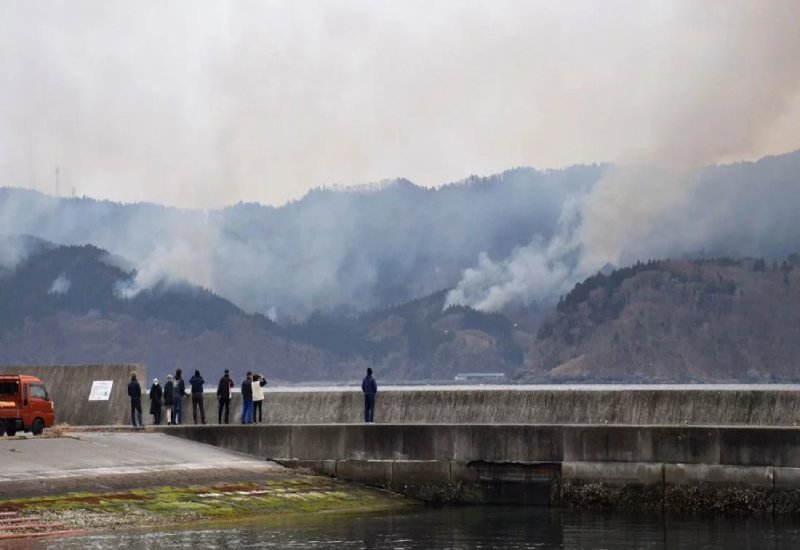- Japan faces its worst wildfire in decades in Ofunato city.
- Over 2,900 hectares have been burned; one person has died.
- Nearly 4,000 residents evacuated as wildfire rages.
- Record-low rainfall and intense winds fueling the flames.
- Experts link the fire to climate change and global warming.
Japan is currently battling one of its worst wildfires in decades near Ofunato, in Iwate Prefecture. The fire, which started on February 26, has already scorched 2,900 hectares, nearly half the size of Manhattan. This wildfire marks the largest one since at least 1975. Sadly, it has claimed one life and forced nearly 4,000 people to evacuate their homes.
As the fire continues to spread, it has severely impacted the local community. Over 80 buildings have either been damaged or destroyed. Many evacuees are now taking shelter in makeshift tents at city halls and public shelters. “Fires are the scariest disaster because they spring from one place to another, and you don’t know where to run,” said 69-year-old evacuee Fumiko Tanaka.
Sadly, many people have lost both their homes and their livelihoods. Tanaka added, “I can only hope the fires won’t reach my house.” Local officials have also pointed out that extreme dryness has worsened the situation, leaving forests and grasslands especially vulnerable to the flames.
Contributing Factors: Climate Change and Weather Conditions
Several factors have fueled the intensity of the wildfire. Ofunato experienced its driest February on record, receiving just 2.5 millimeters of rain—far below the average of 41 millimeters for the month. The region has also been dealing with unusually high temperatures and strong winds that have spread the flames rapidly.
Experts are raising alarms about the role of climate change in intensifying the frequency and severity of such fires. “The warming planet is increasing the likelihood of wildfires in regions that have not experienced them before,” said Greg Mullins, former fire and rescue commissioner for New South Wales, Australia. He also noted that global warming is causing hotter summers, which lead to drying vegetation and increased wildfire risks. Experts predict that with continuing global warming, such fires could become more frequent in areas that have not traditionally been affected by wildfires.
Emergency Response and Relief Efforts
In response to the wildfire, more than 2,000 firefighters and military personnel have been mobilized to fight the flames. The mountainous terrain of the area, with its steep slopes and narrow roads, has made firefighting operations more difficult. Despite these challenges, fire teams continue to work tirelessly on the ground and from the air.
Local businesses have also stepped in to help the affected residents. One such example is Ofunato Onsen, a hot spring facility, which opened its doors for free to evacuees. “Not being able to bathe yourself while dealing with the chaos of shelter life wears you down,” said Toyoshige Shida, the owner of the Onsen.
Mayor Kiyoshi Fuchigami of Ofunato stated that the ongoing firefighting operations demonstrate the severity of the situation. “The fact that teams of firefighters are being reinforced daily indicates how serious the fire is and the difficulties we face,” he said.
The Growing Threat of Wildfires
As extreme weather events become more common, climate change plays a significant role in worsening wildfires. In places like Ofunato, droughts last longer, temperatures rise, and rainfall decreases. Consequently, experts now refer to this as the “new normal” for wildfire seasons. Clearly, these events are becoming more intense and frequent.
Greg Mullins, in his warning, pointed out that similar situations could unfold in other parts of the world. For instance, Europe, the US, and Australia have already witnessed record-breaking fires. These wildfires, in turn, harm ecosystems and cause long-term damage to communities and economies. Thus, they present a serious concern for the future.
The wildfire in Ofunato highlights the increasing risks associated with climate change. This underscores the urgent need to take proactive measures to reduce its effects. While emergency efforts continue, it serves as a reminder that preparation is crucial. Now more than ever, we must act to protect both the environment and our future.
Looking Ahead: The Path Forward
The situation remains dire, but there is hope as wet weather is expected to bring some relief. Light rain and snow on Wednesday offered a brief respite, though authorities continue to monitor the fire closely. The public has been advised to remain vigilant and heed evacuation orders when necessary.
As the fire continues to rage, experts emphasize the need for better preparedness and adaptation strategies to cope with the growing impact of climate change. Wildfires are no longer just a threat to forests—they are becoming a major concern for urban and rural communities alike.


